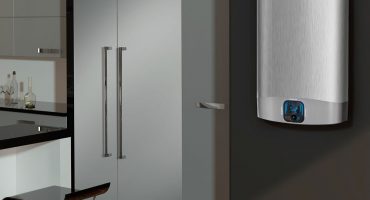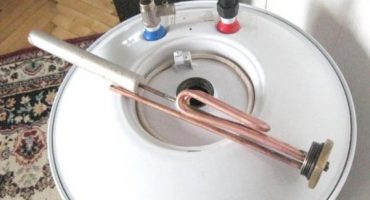The main advantage of instantaneous water heaters is compactness. But at the same time, these household appliances consume a large amount of electricity. Such a consumption is caused by high power, sometimes reaching up to 15 kW. Flowing water heaters belong to the class of reliable and durable devices, breakdowns rarely occur (sometimes due to a fault in the workplace). You should know that the repair of a flowing water heater can be done with your own hands, it is enough to know the algorithm for their search and purchase the necessary tools.
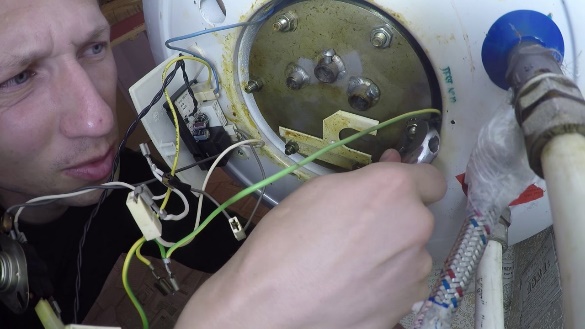
DIY water heater repair
Basic control systems for instantaneous water heaters
Before proceeding with the repair do-it-yourself instantaneous water heater, you should understand its structure and principle of operation. The main elements of the instantaneous water heater:
- Heating element - TEN.
- Pressure switch.
- Temperature sensor.
In addition, the circuit always has wires with different markings, as well as a button to turn on the device and adjust the water temperature (in more expensive models). Water heater manufacturers very often use a standard control scheme, including new elements in it.
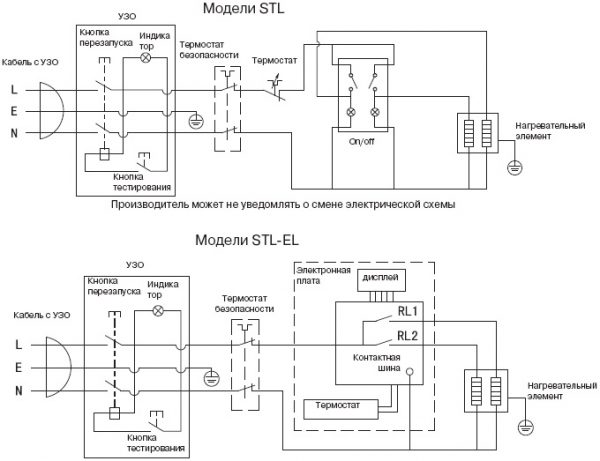
2 water heater control schemes
Above are diagrams of devices of different models of instantaneous water heaters. As you can see, in these water heaters heating elements are provided, to which electric current passes through the temperature control relay, pressure switch and switch. Both relays in the circuit carry a protective function, and trip the network if any parameters are not correct. The switch is used to adjust the operating power of the device.
The lower circuit is additionally equipped with an electronic board that controls the device. In both schemes, a residual current device is provided.
In addition to the phase and neutral wires, a ground connection is also provided here. The circuit is simple, it can be connected independently, using the indicator screwdriver to determine the incoming phase and zero.
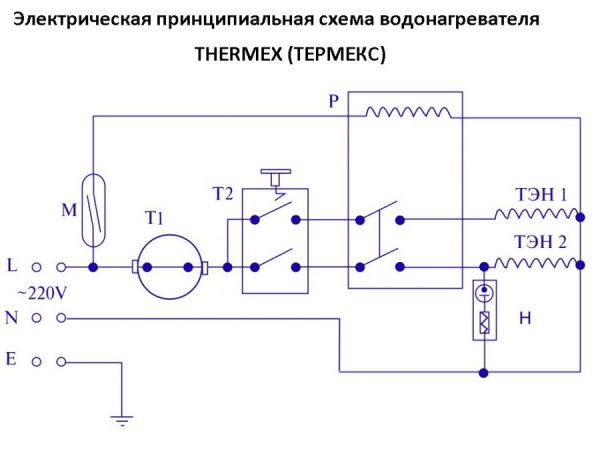
Thermex Water Heater Control Scheme
The above scheme is practically no different from the previous one. A slightly different arrangement of the element, but the functionality remains the same. 2 heating elements allow heating the liquid more or less. The relay responds for their operation, the signal to which the installed early thermostat sends.
An additional element in this circuit is a read sensor, which is connected to the relay. The inclusion of heating elements can occur in automatic mode.
Troubleshooting algorithm
Before fixing a malfunction, it must first be found. Troubleshooting involves the supply of electricity to some parts of the circuit, so all work must be carried out carefully, wearing appropriate protective equipment (gloves, safety glasses).
Troubleshooting Algorithm and Troubleshooting:
- Ensure that the internal failure is not mechanical. For example, a frequent problem is low fluid pressure at the outlet.This can happen due to simple clogging of the watering can, which is installed on the water tap. Fluid inlet and outlet pipes may also become clogged. They must be cleaned with a special solution at least once every six months.
- If the mechanical part is working, then you should start with the input voltage. To do this, you need to purchase a multimeter - a device that allows you to make electrical measurements. Having set the appropriate value on the device (alternating voltage), one probe must be put into phase in the terminal box, the second to zero. A value of 220 V should appear on the multimeter screen. The tolerance is a value greater or less by 10 V.

Inexpensive multimeter for repair of household appliances
In this way, you can check the incoming voltage on any component of the device.
- To check the temperature sensor, it is necessary to measure the voltage at the output of the device and simultaneously monitor the temperature of the liquid. If the temperature rises above the set value, and the sensor does not break the circuit, then the element is faulty. If the voltage comes to the sensor input but does not exit (even when the water has not yet heated), this also means a malfunction of the element.
- The next element in the circuit is a relay that switches the power supply from one heating element to another. It is enough to force the operating voltage to its input, and the relay will let it through itself. If there is no voltage at the output of the element, this means a relay malfunction.
- The last and most important element of the electric circuit of the water heater is the heating element. The heater is a curved tube with a metal spiral inside, on top of the ceramic body. An electric current flows in a spiral, it heats up and transfers part of the heat to the liquid. For TEN check, it must be removed and checked for resistance. Too much resistance means breakdown of the element, respectively - its replacement.
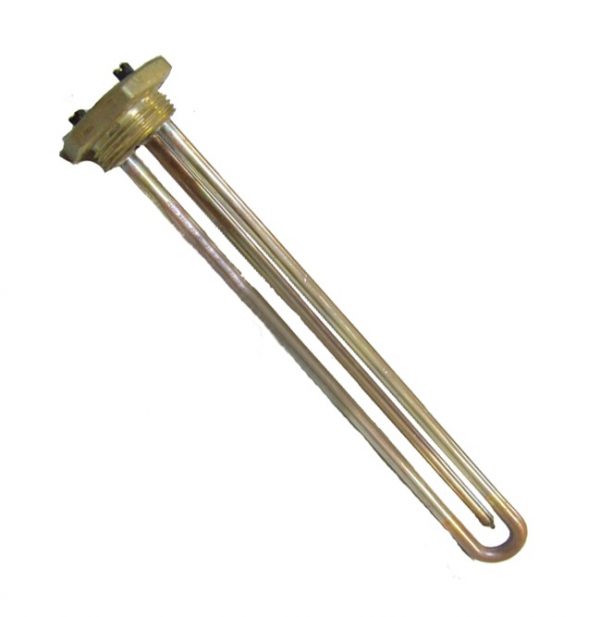
TEN with a power of 1500 W
Sometimes the most high-quality and reliable way to determine the malfunction is a visual inspection of the household appliance. For example, the cause of a pressure drop may be a simple tank leak, which has arisen due to a long service life and poor-quality water.
What is thermal protection in a instantaneous water heater
Instantaneous water heaters are equipped with thermal protection elements - temperature control sensors. If the sensor fails, the water in the device quickly reaches a high temperature, and the pressure increases accordingly. Both the water heater itself and the heating elements - heating elements can be damaged.
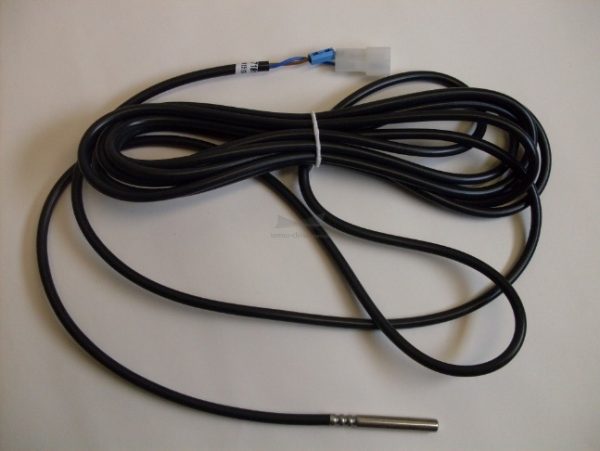
Example temperature sensor for a boiler
The operation of the temperature control sensor is to interrupt the electrical circuit when a certain water temperature is reached. The most common overheating sensor (both electric and gas) is triggered at 60 ° C. After which the water cools, the sensor turns on the electric circuit, and the heating of the liquid begins anew.
In addition to the main temperature control sensor, an additional one is also installed. It has the function of backup circuit disconnection if the main sensor does not work. The backup element will open the circuit at 90 ° C. It should be remembered that the backup sensor must be turned on manually, since it does not work in automatic mode. Usually it is turned on by replacing the main one.
How to replace a temperature sensor
The temperature sensor is usually installed as close to the water outlet as possible. Fastens to the body with four bolts or with hex screws. Some models of temperature sensors have a collapsible housing, which allows you not to buy a new sensor, but to restore the old one yourself.
The procedure for replacing the temperature sensor:
- Drain the water.
- Remove four bolts or screws. For screws it is necessary to use a hexagon or a figured screwdriver, for bolts - the corresponding wrench.
- Remove the wires, having previously marked them with a marker. The wire is attached to the sensor terminals with screws. It should be remembered that before starting work, the water heater must be disconnected from the network.
- Remove the old sensor and install a new one in its place, fasten with bolts or screws. It is necessary to purchase exactly the same element, otherwise the attachment points may not coincide.
- Connect the wires and tighten the contact points properly.
- Pour water and turn on the water heater. Check its functioning.
The most frequent breakdowns and methods for their elimination
Instantaneous water heaters are quite simply arranged if they do not have additional electronic control units. If any malfunction occurs, you can simply seek help from the list in which they are all indicated. The list of malfunctions also includes methods for resolving them.
Breakdown number 1: blown heater
The most common failure, in which the household appliance continues to function even when the warning light is on, as electric current reaches the heating element but does not pass through it.

Burnt heater of a water heater
We repair the heater in the following order:
1. Disconnect the water heater from the mains and drain the water out of it.
2. Remove the heating element. To do this, you need to unscrew a few bolts securing it to the body of the water heater.
3. Attach the working probes of the multimeter to the two main conclusions of the heating element, having previously set the resistance measurement. The working resistance of the heater is 32-35 Ohm. If the multimeter shows a unit, it means that the heater is damaged.
Installation of an element occurs in the reverse order. Also, do not forget about the rubber gasket under the heater. If the gasket has become unusable, then it should be replaced.
Failure No. 2: clogging of a household appliance
A clogged water heater may result in too low outlet pressure. An incomprehensible noise is also heard, similar to the passage of large debris through the pipes of the system.
With such a breakdown, all the working elements of the electrical circuit remain operational, so it can take a lot of time to find the fault. A clogged water heater does not require repair, it should only be cleaned with high quality.
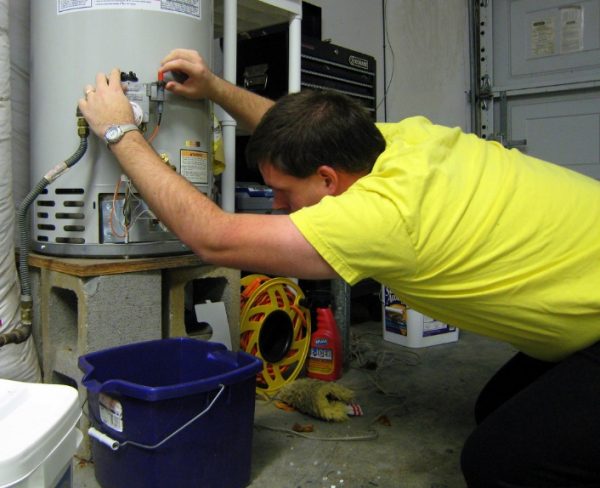
Water heater clogging
The procedure for cleaning the instantaneous water heater:
1. The device must be de-energized and all the water in the system drained.
2. It is necessary to remove 2 wires from the heater: phase and zero. Then undock the heater and rinse it thoroughly in hot water. Do not use hard objects to remove scale and rust, as this may damage the element case.
3. Flush the intake and discharge pipes under low pressure. For the best effect, it is allowed to use household chemicals with a mild action, without active elements.
4. Install the heater in the reverse order. Turn on the device and check its functionality.
Failure No. 3: the power switch does not work
Multistage power switches are installed mainly on the models of the latest generations of boilers. This allows you to precisely control the temperature of the water and save on electricity. The consequence of a failure of the power regulator: the device does not react in any way to the rotation of the operating mode switching handle. The output may be a slightly heated liquid, while the pressure remains normal.
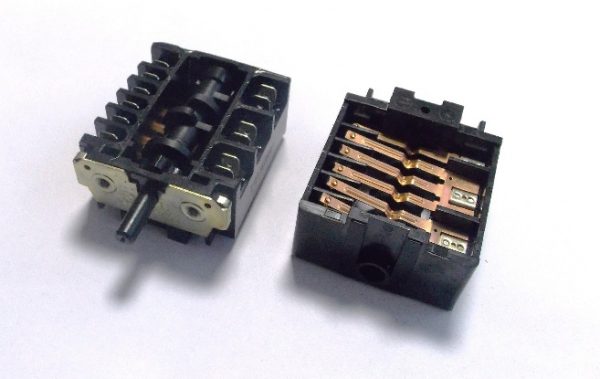
Standard power switch
Most often, the power switch is a variable rheostat, which can be checked with a multimeter. It is necessary to connect the probes to the terminals of the element and smoothly rotate the adjustment knob. If the resistance changes, then the rheostat is working, if not, then it should be replaced. When replacing, it is necessary to mark the wires and connect them to the corresponding terminals of the switch. A switch is better to buy an original, rather than a cheaper analogue.
Failure No. 4: the external tank is broken
With a long service life, the water tank may leak. The integrity of the material is also affected by the quality of the heated fluid - very often, after several months of operation, scale forms on the surface of the heating element.
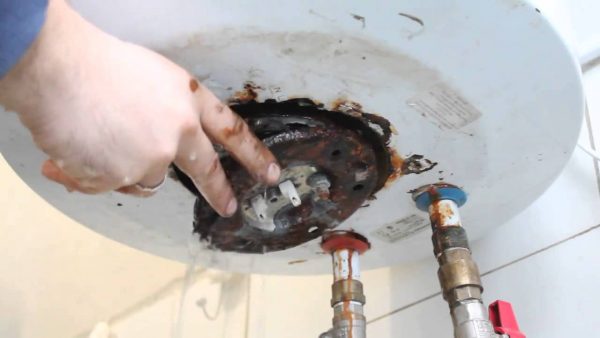
Damage to the external tank
With a punctured case, the liquid pressure at the outlet drops sharply, the device body may be covered with fluid leaks. This malfunction is determined quickly by visual inspection.
Another cause of water leakage may be a damaged rubber gasket under the heater - the so-called flange. To replace the gasket, it is enough to drain the water, disconnect the water heater from the network and remove the heating element. Having taken out the old gasket, it is necessary to put a new one in its place and assemble the device in the reverse order.

